Although the question is several years old, I still come across the same issue from time to time in several different developer sites. So I thought I may contribute an alternative solution, which I use for my everyday-developer-work (since the Windows registry settings never worked for me).
The following is my small Autorepeat-Script (~ 125 lines), which can be run via AutoHotkey_L (the downside is, it only runs under Windows, at least Vista, 7, 8.1):
; ====================================================================
; DeveloperTools - Autorepeat Key Script
;
; This script provides a mechanism to do key-autorepeat way faster
; than the Windows OS would allow. There are some registry settings
; in Windows to tweak the key-repeat-rate, but according to widely
; spread user feedback, the registry-solution does not work on all
; systems.
;
; See the "Hotkeys" section below. Currently (Version 1.0), there
; are only the arrow keys mapped for faster autorepeat (including
; the control and shift modifiers). Feel free to add your own
; hotkeys.
;
; You need AutoHotkey (http://www.autohotkey.com) to run this script.
; Tested compatibility: AutoHotkey_L, Version v1.1.08.01
;
; (AutoHotkey Copyright © 2004 - 2013 Chris Mallet and
; others - not me!)
;
; @author Timo Rumland <timo.rumland ${at} gmail.com>, 2014-01-05
; @version 1.0
; @updated 2014-01-05
; @license The MIT License (MIT)
; (http://opensource.org/licenses/mit-license.php)
; ====================================================================
; ================
; Script Settings
; ================
#NoEnv
#SingleInstance force
SendMode Input
SetWorkingDir %A_ScriptDir%
; Instantiate the DeveloperTools defined below the hotkey definitions
developerTools := new DeveloperTools()
; ========
; Hotkeys
; ========
; -------------------
; AutoRepeat Hotkeys
; -------------------
~$UP::
~$DOWN::
~$LEFT::
~$RIGHT::
DeveloperTools.startAutorepeatKeyTimer( "" )
return
~$+UP::
~$+DOWN::
~$+LEFT::
~$+RIGHT::
DeveloperTools.startAutorepeatKeyTimer( "+" )
return
~$^UP::
~$^DOWN::
~$^LEFT::
~$^RIGHT::
DeveloperTools.startAutorepeatKeyTimer( "^" )
return
; -------------------------------------------------------
; Jump label used by the hotkeys above. This is how
; AutoHotkey provides "threads" or thread-like behavior.
; -------------------------------------------------------
DeveloperTools_AutoRepeatKey:
SetTimer , , Off
DeveloperTools.startAutorepeatKey()
return
; ========
; Classes
; ========
class DeveloperTools
{
; Configurable by user
autoRepeatDelayMs := 180
autoRepeatRateMs := 40
; Used internally by the script
repeatKey := ""
repeatSendString := ""
keyModifierBaseLength := 2
; -------------------------------------------------------------------------------
; Starts the autorepeat of the current captured hotkey (A_ThisHotKey). The given
; 'keyModifierString' is used for parsing the real key (without hotkey modifiers
; like "~" or "$").
; -------------------------------------------------------------------------------
startAutorepeatKeyTimer( keyModifierString )
{
keyModifierLength := this.keyModifierBaseLength + StrLen( keyModifierString )
this.repeatKey := SubStr( A_ThisHotkey, keyModifierLength + 1 )
this.repeatSendString := keyModifierString . "{" . this.repeatKey . "}"
SetTimer DeveloperTools_AutoRepeatKey, % this.autoRepeatDelayMs
}
; ---------------------------------------------------------------------
; Starts the loop which repeats the key, resulting in a much faster
; autorepeat rate than Windows provides. Internally used by the script
; ---------------------------------------------------------------------
startAutorepeatKey()
{
while ( GetKeyState( this.repeatKey, "P" ) )
{
Send % this.repeatSendString
Sleep this.autoRepeatRateMs
}
}
}
- Save the code above in a text file (UTF-8), for example named "AutorepeatScript.ahk"
- Install AutoHotkey_L
- Double click on "AutorepeatScript.ahk" to enjoy much fast arrow-keys (or put the file into your autostart-folder)
(You can adjust the repeat delay and rate in the script, see '; Configurable by user').
Hope this helps!
